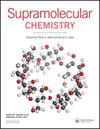柱[4]芳烃[1]醌类伪[3]轮烷的主-客体协同结合
IF 2.6
4区 化学
Q3 CHEMISTRY, MULTIDISCIPLINARY
引用次数: 1
摘要
通过核磁共振光谱分析和高分辨率质谱分析,确定了P4Q1和H与双咪唑和双吡啶形成伪[3]轮烷组装体。通过1H NMR滴定实验得到的结合常数值,深入研究了伪[3]轮烷组装过程中的协同性。结果表明,柱[4]芳烃[1]醌通过正协同作用优先进行1:1的主-客结合,功能化柱[4]芳烃[1]醌通过正协同作用优先进行2:1的主-客结合。柱[4]芳烃[1]醌醌基上的氢键官能团的存在促进了包合物的形成,从而形成伪[3]轮烷。图形抽象本文章由计算机程序翻译,如有差异,请以英文原文为准。
Pillar[4]arene[1]quinone-based pseudo[3]rotaxanes by cooperative Host-Guest binding
ABSTRACT Formation of pseudo[3]rotaxane assemblies by P4Q1 and H with bis-imidazolium and bis-pyridinium guests was established by NMR spectral analyses and high-resolution mass spectrometric analyses. Cooperativity in the formation of pseudo[3]rotaxane assemblies was thoroughly investigated from the binding constant values derived from 1H NMR titration experiments. The results indicated the preferential 1:1 host-guest binding of pillar[4]arene[1]quinone and 2:1 host-guest binding by functionalized pillar[4]arene[1]quinone via positive cooperativity. The presence of hydrogen bonding functional groups attached to the quinone motif of pillar[4]arene[1]quinone facilitated the inclusion formation, which resulted in the formation of pseudo[3]rotaxanes. Graphical abstract
求助全文
通过发布文献求助,成功后即可免费获取论文全文。
去求助
来源期刊

Supramolecular Chemistry
化学-化学综合
CiteScore
3.60
自引率
3.00%
发文量
5
审稿时长
2.7 months
期刊介绍:
Supramolecular Chemistry welcomes manuscripts from the fields and sub-disciplines related to supramolecular chemistry and non-covalent interactions. From host-guest chemistry, self-assembly and systems chemistry, through materials chemistry and biochemical systems, we interpret supramolecular chemistry in the broadest possible sense. Interdisciplinary manuscripts are particularly encouraged. Manuscript types include: high priority communications; full papers; reviews, and; Methods papers, techniques tutorials highlighting procedures and technologies that are important to the field. We aim to publish papers in a timely fashion and as soon as a paper has been accepted and typeset it will be published in electronic form on the Latest articles section of the website. The two most important review criteria are that the paper presents high-quality work that fits generally into the broad spectrum of activities in the supramolecular chemistry field. Under normal circumstances, Supramolecular Chemistry does not consider manuscripts that would be more suitable in a highly specialized journal. This includes, but is not limited to, those based mostly or exclusively on topics such as solid state/X-ray structures, computational chemistry, or electrochemistry. .
The two most important review criteria are that the paper presents high-quality work that fits generally into the broad spectrum of activities in the supramolecular chemistry field.
 求助内容:
求助内容: 应助结果提醒方式:
应助结果提醒方式:


